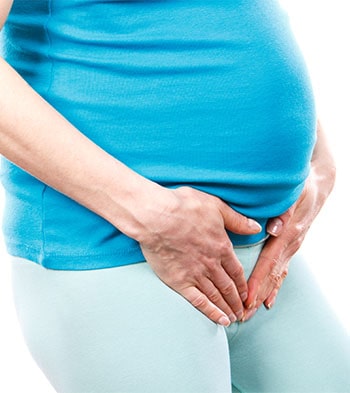Pregnancy – Physiotherapy

IF YOU ARE EXPERIENCING ANY OF THE FOLLOWING WHEN YOU ARE PREGNANT, CONSULT WITH A PELVIC PHYSIOTHERAPIST:
- Pain in your pelvis, back, groin or legs
- Urinary or fecal incontinence
- Pain with intercourse
- Abdomen tenting when you lift your head off a pillow (diastasis recti)
- Pelvic girdle pain with doing your everyday tasks such as rolling over, walking, or getting in/out of a vehicle
- Vaginal swelling or varicose veins in the legs
- Concerns or questions about preparing for labour and delivery
- Pubic symphysis dysfunction
WHAT DOES THE RESEARCH SAY ABOUT PELVIC FLOOR MUSCLE TRAINING DURING PREGNANCY?
Women who did Pelvic Floor Muscle Training (PFMT) between 20 and 36 weeks of pregnancy had a lower rate of prolonged second stage labour than women who did no training, less pregnancy-related low back and pelvic pain than those who did no training, less likely to have urinary incontinence at 36 weeks of pregnancy and 3 months post-partum. Click here to learn more.
WHY SHOULD I SEE A PELVIC PHYSIOTHERAPIST WHILE I AM PREGNANT?
- Provide education on what is common during pregnancy
- Discuss activities of daily living and safe exercises
- Review transfers in functional way
- Improve pelvic floor muscle strength
- Discuss posture and positioning
- Help prepare you for labour and delivery
- Provide treatment for pubic symphysis pain, sacroiliac joint pain or low back pain
- The benefits of starting a pelvic floor muscle exercise for the prevention and treatment of urinary incontinence is documented in this review.
DID YOU KNOW?
- About one-third of women have urinary incontinence and up to one-tenth have faecal incontinence after childbirth. Pelvic floor muscle training (PFMT) is commonly recommended during pregnancy and after birth for both prevention and treatment of incontinence. Click to learn more.
- During pregnancy 42% of women have urinary incontinence (Kari Bo, Siv Morkveed 2000) and 1 in 10 have fecal incontinence after childbirth (Hay-Smith et al 2008).
- There is level 1 evidence that pelvic floor training with a pelvic physiotherapist who uses internal palpation is recommended to prevent incontinence both during and after delivery.
- Perineal massage can be beneficial to the muscles prior to delivery.
CAN I EXERCISE WHILE I AM PREGNANT?
Yes, and it is recommended as long as you listen to your body and there are no contraindications.
WHAT ARE THE CONTRAINDICATIONS FOR EXERCISING WHILE PREGNANT?
According to the Society of Obstetricians and Gynaecologists of Canada (SOGC) they are:
- Weakened cervix
- Growth-restricted fetus
- Placenta previa after 28 weeks gestation
- Uncontrolled type 1 diabetes, hypertension or thyroid disease
- Preeclampsia
- Multiple pregnancy of triplets or more
- Unexplained vaginal bleeding
- High blood pressure
- Severe anemia
- Ruptured membranes or premature labour
- Other serious diseases such as heart or lung disease
WHAT DO I NEED TO THINK ABOUT WHILE I AM PREGNANT AND EXERCISING?
- Drink lots of water during and after exercise
- Wear a supportive bra and comfortable shoes
- Wear layers of clothing
- Incorporate proper kegels as needed with your exercises
- Listen to your body — use the talk test to determine how hard you should exercise
WHAT ARE THE BENEFITS OF EXERCISING WHILE PREGNANT?
- Helps your body get strong for labour and delivery
- Helps with mood and increasing energy level
- Improves bowel function and decreases constipation
- Improves sleep
- Helps with weight management
